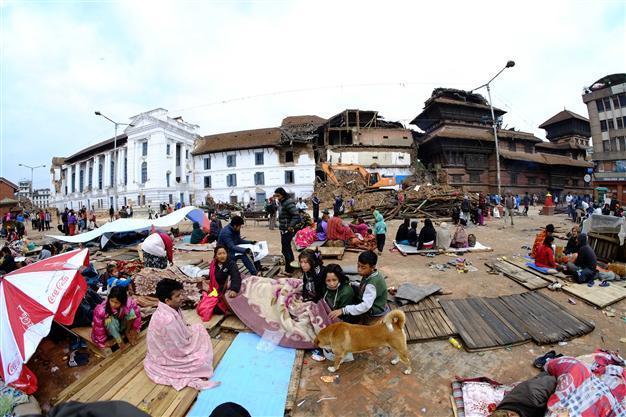Nepal scrambles to organise quake relief, many flee capital
KATHMANDU - Reuters

AA Photo
Nepalese officials scrambled on April 27 to get aid from the main airport to people left homeless and hungry by a devastating earthquake two days earlier, while thousands tired of waiting fled the capital Kathmandu for the surrounding plains.By afternoon, the death toll from April 25 7.9 magnitude earthquake had climbed to more than 3,700, and reports trickling in from remote areas suggested it would rise significantly.
A senior interior ministry official said it could rise to as high as 5,000, in the worse such disaster in Nepal since 1934, when 8,500 people were killed.
Kathmandu's Tribhuvan International Airport was hobbled by many employees not showing up for work, people trying to get out, and a series of aftershocks which forced it to close several times since the quake.
Home Minister Bam Dev Gautam was supervising aid delivery and arranging for passengers to leave the country.
Government officials said they needed more supplies of food, medicines, specialized rescue services and body bags.
"
The morgues are getting totally full," said Shankar Koirala, an official in the Prime Minister's Office who is dealing with the disposal of bodies.
Families lit funeral pyres for the dead in towns and across the countryside.
Flight from Kathmandu
Many of Kathmandu's one million residents have slept in the open since Saturday, either because their homes were flattened or they were terrified that aftershocks would bring them crashing down.
On April 27, thousands streamed out of the city. Roads leading from Kathmandu were jammed with people, some carrying babies, trying to climb onto buses or hitch rides aboard cars and trucks to the plains. Huge queues had formed at the airport.
"We are escaping," said Krishna Muktari, who runs a small grocery store in Kathmandu, standing at a road intersection.
Meanwhile, the extent of Nepal's disaster was only just emerging as reports of devastation began to come in from other parts of the country.
High in the Himalayas, hundreds of climbers were staying put at Mount Everest base camp, where a huge avalanche after the earthquake killed 17 people in the single worst disaster to hit the world's highest mountain.
Rescue teams, helped by clear weather, used helicopters to airlift scores of people stranded at higher altitudes, two at a time.
In Sindhupalchowk, about a three-hour drive northeast of Kathmandu, the death toll had reached 875 people and was expected to rise. In Dhading, close to the quake's epicentre west of Kathmandu, 241 people were killed.
Survivors spoke of trying to stay flat on the ground while the tremors shook the forested mountains. Some were stuck for hours afterwards, unable to move because of injuries.
"There is nobody helping people in the villages. People are dying where they are," said A. B. Gurung, a Nepali soldier who was waiting in Dhading district for an Indian helicopter that had gone to his village Darkha.
Aid trickles in
In Kathmandu, sick and wounded people were lying out in the open, unable to find beds in the devastated city's hospitals. Surgeons set up an operating theatre inside a tent in the grounds of Kathmandu Medical College.
Across the capital and beyond, exhausted families laid mattresses out on streets and erected tents to shelter from rain. People queued for water dispensed from trucks, while the few stores still open had next to nothing on their shelves.
Some relief supplies began to trickle into the capital, a Reuters witness said. Some portable toilets had been set up and food was being provided by local aid agencies.
A few United Nations vehicles were seen with medical equipment and first aid kits.
The United Nations Children's Fund said nearly one million children in Nepal were severely affected by the quake, and warned of waterborne and infectious diseases.
In the ancient temple town of Bhaktapur, east of Kathmandu, many residents were living in tents in a school compound after centuries old buildings collapsed or developed huge cracks.
"We have become refugees," said Sarga Dhaoubadel, a management student whose ancestors had built her Bhaktapur family home over 400 years ago.
They were subsisting on instant noodles and fruit, she said.
"No one from the government has come to offer us even a glass of water," she said. "Nobody has come to even check our health. We are totally on our own here. All we can hope is that the aftershocks stop and we can try and get back home."
A total of 3,726 people were confirmed killed in the quake, the government said on April 27. More than 6,500 were injured.
Another 66 were killed across the border in India and at least another 20 in Tibet, China's state news agency said.
Several countries rushed to send aid and personnel.
India sent helicopters, medical supplies and members of its National Disaster Response Force. China sent a 60-strong emergency team. Pakistan's army said it was sending four C-130 aircraft with a 30-bed hospital, search and rescue teams and relief supplies.
A Pentagon spokesman said a U.S. military aircraft with 70 personnel left the United States on April 26 and was due in Kathmandu on Monday. Australia, Britain and New Zealand said they were sending specialist urban search-and-rescue teams to Kathmandu at Nepal's request.
Britain, which believes several hundred of its nationals are in Nepal, was also delivering supplies and medics.
The disaster has underlined the woeful state of Nepal's medical facilities.
Nepal has only 2.1 physicians and 50 hospital beds for every 10,000 people, according to a 2011 World Health Organization report.
















